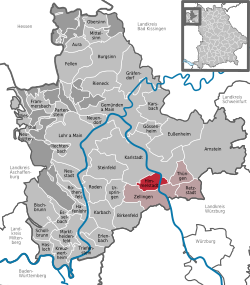Himmelstadt | |
|---|---|
Location of Himmelstadt within Main-Spessart district  | |
| Coordinates: 49°55′N9°48′E / 49.917°N 9.800°E | |
| Country | Germany |
| State | Bavaria |
| Admin. region | Unterfranken |
| District | Main-Spessart |
| Municipal assoc. | Zellingen |
| Government | |
| • Mayor (2018–24) | Herbert Hemmelmann [1] (CSU) |
| Area | |
• Total | 13.42 km2 (5.18 sq mi) |
| Elevation | 165 m (541 ft) |
| Population (2023-12-31) [2] | |
• Total | 1,560 |
| • Density | 120/km2 (300/sq mi) |
| Time zone | UTC+01:00 (CET) |
| • Summer (DST) | UTC+02:00 (CEST) |
| Postal codes | 97267 |
| Dialling codes | 09364 |
| Vehicle registration | MSP |
| Website | www.himmelstadt.de |
Himmelstadt is a municipality in the Main-Spessart district in the Regierungsbezirk of Lower Franconia (Unterfranken) in Bavaria, Germany and a member of the Verwaltungsgemeinschaft (Administrative Community) of Zellingen.
Contents
- Geography
- Location
- History
- Population development
- Politics
- Coat of arms
- Economy and infrastructure
- Education
- References
- External links
Because of the community’s “heavenly” name – Himmel means “heaven” or “sky” in German – the Weihnachtspostamt Himmelstadt (“Himmelstadt Christmas Post Office”) has existed since 1986, jointly run by Deutsche Post and the community.



